It’s a daily ritual, a symbol of Argentine identity, and a South American superfood.

Yerba mate is Argentina’s official national drink and the country’s second most-consumed beverage after water.
Across Argentina, people have mate on the mind when they place the kettle on the stove first thing in the morning.
A good day in Argentina starts with the birdsong and a mate.
In the afternoon, mate is the preferred pick-me-up in work meetings.
At night, it’s a trusty companion for all-night study sessions and lonely graveyard shifts.
The Pope and Lionel Messi drink it daily.
In 2019, mate even got an emoji. 🧉
All this underlines what Argentines have known for hundreds of years: mate is the ‘Drink of the Gods.’
What is Yerba Mate?
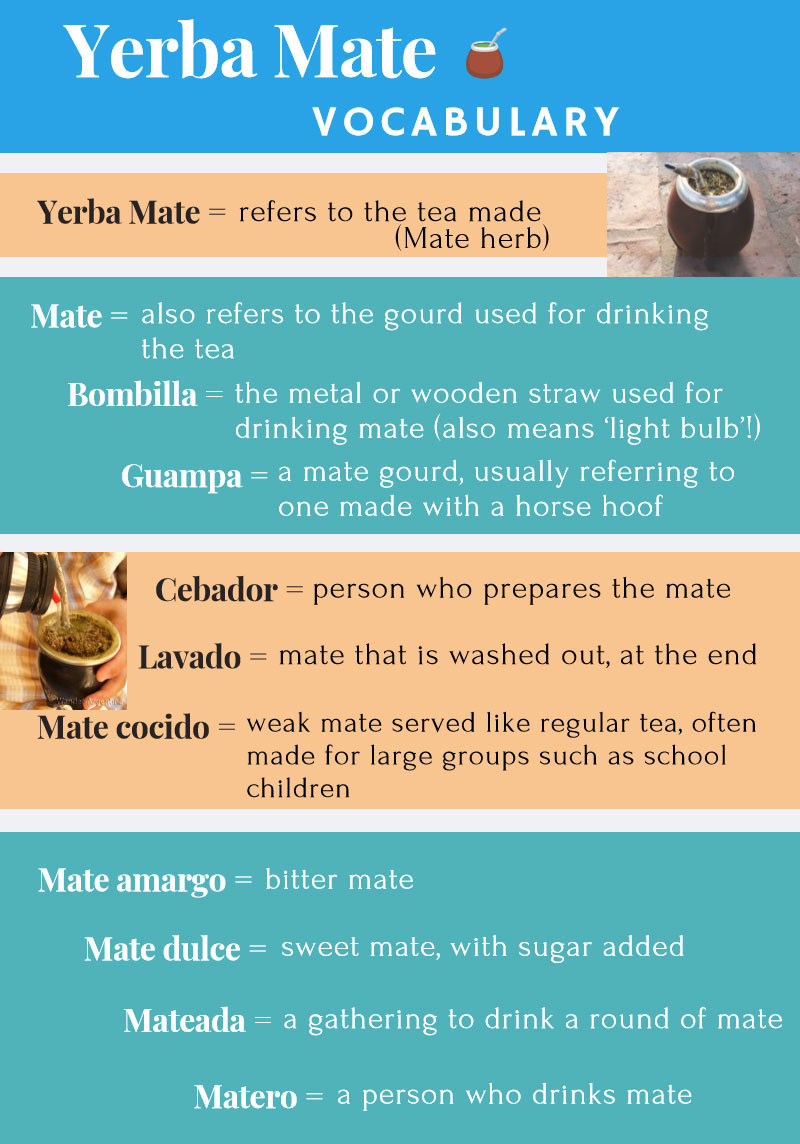
Yerba mate (pronounced SHerba MAH-tey) is an evergreen shrub from the Holly family native to the Atlantic Forest of Argentina, Paraguay and Southern Brazil.
The leaves of the plant (Ilex paraguariensis) are ground to make a healthy infusion. Even though it is commonly referred to as a tea, technically it is not.
The first thing to understand about mate is that it is not simply a tea bag placed in a cup. It can’t be ordered at a restaurant. To drink mate requires a special setup: a ‘mate’ and a ‘bombilla.’
Mate, derived from the Quechua word ‘mati,’ refers to the bulbous drinking vessel, traditionally a hollowed-out gourd.
Modern commercial mates can also be made out wood, bamboo or ceramic. Gauchos (Argentine cowboys) often use the most fanciful mates, made out of either a carved-out cow hoof or horn called a guampa.
Materos, as mate consumers are known, love yerba mate for its ability to increase concentration and focus.
Cowboys on the pampas and city slickers alike enjoy how it staves off hunger and has stimulant properties that help one to push through the workday with relative ease.
The Mate Ritual: Argentina’s Real Life ‘Social Networking’
“From you to me, hand to hand, the mate comes and goes. The mate is like a dialogue, with pauses to fill” – Ezequiel Martínez Estrada, 1927
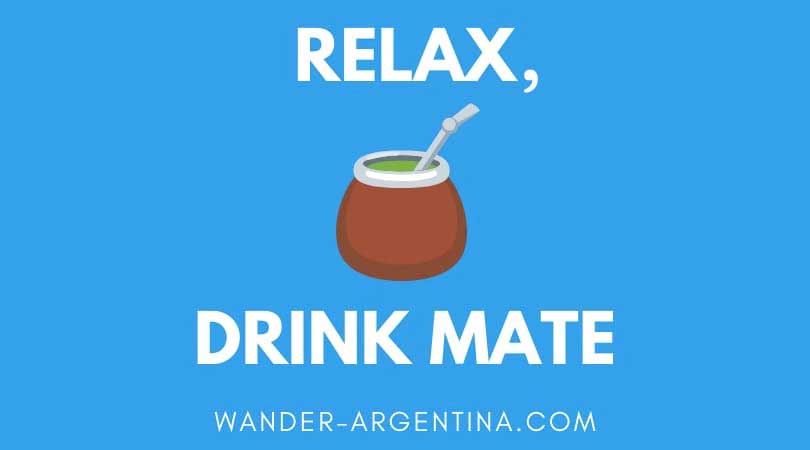
In Argentina, the first thing one says to a friendly houseguest is, ‘¿Tomamos unos mates? (Should we drink some mates?)’
Offering mate to a visitor is the most common welcome gesture in this part of the world and the proposal is rarely turned down.
There is never a bad time for mate, and turning down the offer could be taken as a snub.
In a ‘mateada’ or mate round, one person acts as the server. Everyone shares the same mate ‘cup,’ and ‘straw.’ The cebador, or server, heats the water — never boiling it — that is a major taboo because boiled water ruins the yerba.
Meanwhile, the mate is filled ¾ full with the ‘yerba mate’ (mate herb). The mate vessel is inverted and shaken to mix the herb and to remove any dust.
The server artfully creates a sloping mound of herb in the mate, wetting it at the lowest point. A bombilla, the special straw used to filter out the leaf material, is then placed into the bottom of the mate.
The server drinks the first mate to check the water temperature and because it is the most bitter. He then carefully refills the mate with water for each participant.
Each person takes turns slurping up all the water, before handing the mate back to the server. Among new acquaintances it is customary to compliment the serving skills of the cebador or the mate itself, to ingratiate oneself with the host.
The liturgy can continue for hours, with the mate server refreshing the yerba as it loses flavor.
How to Make & Drink Mate like a Local
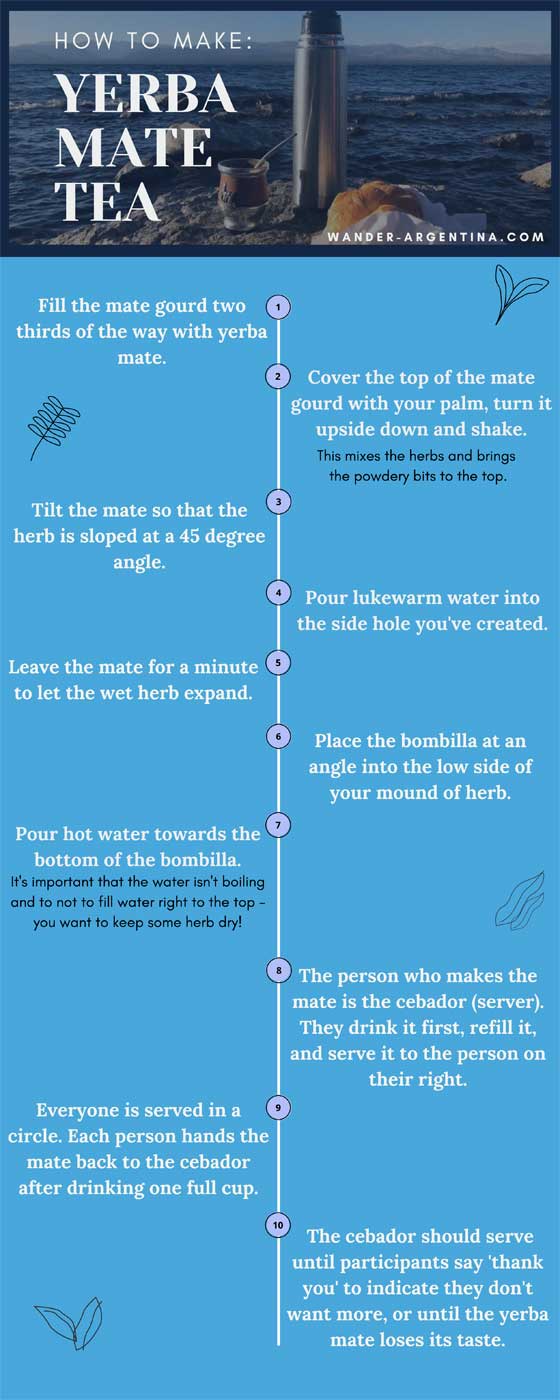
Among foreigners living in Argentina, a solid indication of assimilation is the ability to prepare and serve mate.
“When I first came here I thought mate was so lovely and so unique and really represents the culture,” says Tilly Dale, a recent British graduate living in Sante Fe, Argentina.
Dale still starts her day with a traditional cup of English tea, but quickly picked up the custom of sipping mate while working in the afternoon, or with her boyfriend on weekend mornings.
Foreigners invited to drink mate usually need to learn a few ground rules in order not to offend their hosts.
The first rule is to never touch the bombilla. Moving or touching the straw can clog it and exhaust the yerba quicker. Only the server touches the bombilla, or makes adjustments to the herb.
It is especially offensive to wipe off the tip of the bombilla to clean off any germs — that’s like announcing you think the others have cooties.
Foreigners should also not reflexively say, ‘thank you’ when handing the mate back to cebador the first round. Saying ‘thank you’ means you don’t want anymore.
Thanking the cebador after one mate could indicate one does not want to extend the friendship, so when bowing out of a mateada it’s best to offer a polite excuse to the contrary.
“I like the ritual of preparing mate, it’s fun,” says Richard Shpuntoff, a Buenos Aires-based documentary filmmaker originally from New York. “There’s something fun about preparing it and sharing it with other people.”
“You know the people who convert to a religion and are more serious about it then the people who grew up with it? I’m like that with mate.”
“When someone boils the water, I’m like, ‘Oh God! No!’”
What Does Yerba Mate Taste Like?
Mate drunken the traditional way is a bitter shock to the senses at first. Its taste is described as earthy, grassy, with musky undertones, but most of all ‘bitter’.
“It’s like drinking a cigarette — disgusting at first, but addictive,” says Ginger Gentile, a filmmaker who lived in Argentina for 13 years.
Now that she has returned to the U.S., she hasn’t given up her mate habit, drinking it every morning.
Those who find mate too bitter sweeten it. Often Argentine households will use different gourds for ‘mate amargo’ (bitter mate) and ‘mate dulce’ (sweet mate).
‘Mate cocido’ is loose yerba boiled in water that is often made in the countryside or for large groups, such as schoolchildren. This version of mate is much milder both in taste and caffeine content.
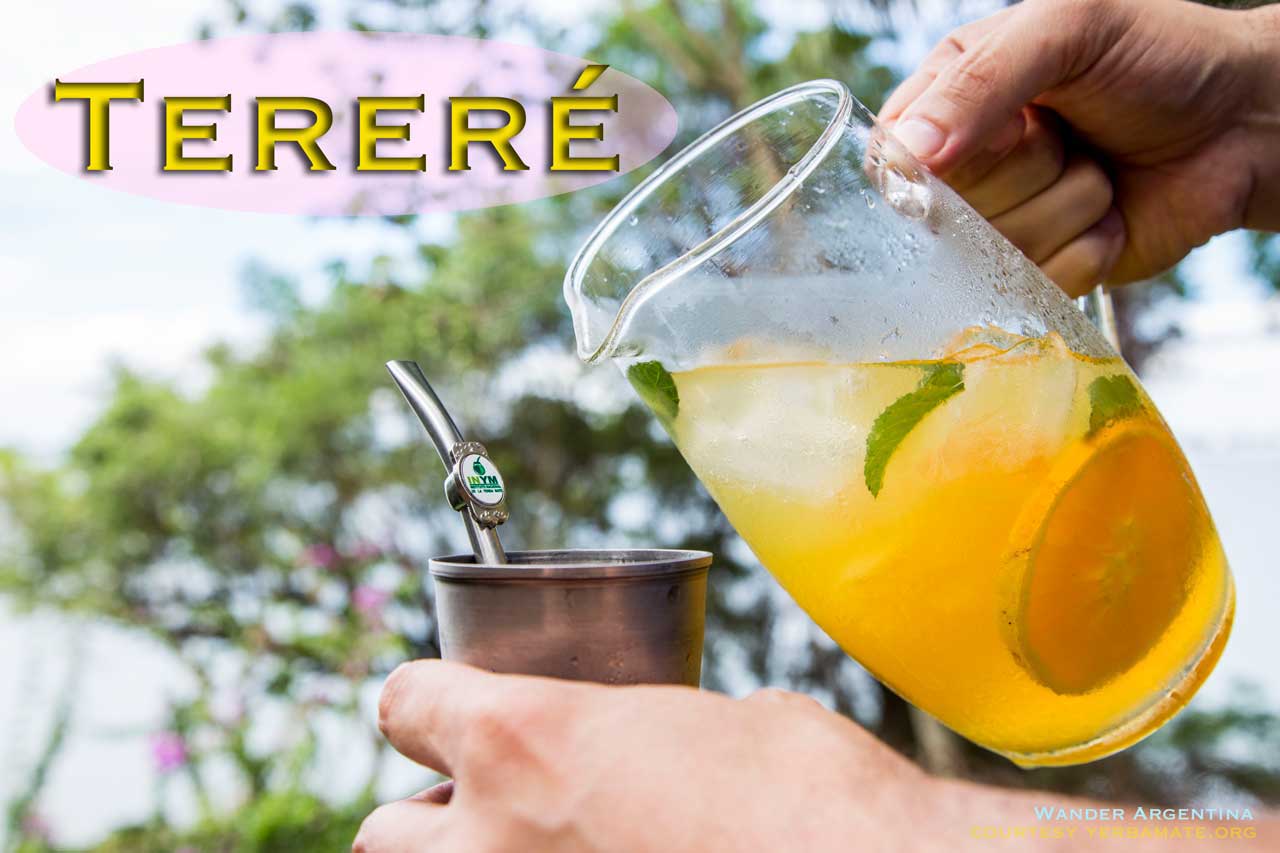
In the warm regions of Paraguay and southern Brazil (where mate is called chimarrão or cimarrón) it’s common to drink tereré, or cold mate.
It can be made with loose tea or tea bags left in water in the sun all day, and then strained and poured over ice.
Once a taste for traditional mate is acquired, it sticks. In the 1857 tango tune by Santiago Ramos, ‘Tomá Mate, che’ (Drink Mate, che) the singer uses mate as his tool of seduction, proclaiming to his lover it, “is better, without a doubt, than coffee, than chocolate.”
“Drink mate, and wake up,” sings Ramos. “Whoever comes to our land won’t leave if he drinks mate.”
While this might have been true back then, when travel was toilsome, in modern times visitors to Argentina are taking their mate habit back home.
The Guaraní’s Drink of Friendship: Caá Yarí
“Many are the virtues that are attributed to yerba; it brings sedative effects at the same time it stimulates, it also calms hunger while it favors digestion. It restores strength, instills joy and cures various diseases.”- Father Nicolás del Techo, 1673
Argentina’s Misiones province, home to one of the country’s main tourist attractions, Iguazu Falls, is also the epicenter of yerba mate production. The province produces 60% of the world’s yerba mate supply.
Long before the Spanish conquerors arrived, Guaraní tribes not only drank mate daily, they worshiped the plant, and it was their most important commodity for trade.
There are many Guaraní myths and legends involving yerba mate. According to one folktale, yerba mate was a thank you gift from the moon Goddess, Yaví.
The cloud God, Araí, told her about the beautiful jungle, which, being the moon, she could not see at night.
One day Yaví decided to transform into a young woman to visit earth and explore the jungle during the daytime. As she was meandering along, looking at plants and listening to the beautiful sounds of nature, she was suddenly confronted by a jaguar. It was right in front of her growling and bearing its teeth, ready to pounce.
She braced herself the final moment before she was going to be attacked and eaten. Just as the beast lunged at her, an arrow came flying by right straight into the heart of the jaguar.
Relieved, she looked around to see who saved her. Off in the distance, she saw an old hunter putting down his bow.
He waved in a friendly manner and then walked away.
That night the hunter had a dream. In his sleep he was visited by the girl he saved from the jaguar in the jungle. In his strange semi-lucid vision she told him that he would wake up in the morning and find ‘magic seeds’ for a plant called Caá (yerba in Guaraní).
The leaves of the Caá plant could be used for a ‘drink of friendship’ that would endure for generations and create unity among people.
The moon God also rewarded the hunter’s beautiful daughter with eternal life as a deity named Caá Yarí.
According to Guaraní legend the goddess is a generous protector of the jungle, but jealous. Caá Yarí demands celibacy and the faithful steward of mate from harvesters in exchange for protecting the plants, or else she takes her revenge.
When someone dies in the Misiones jungle, the death is blamed on the vengeance of Caá Yarí.
Caá Yari highlights the importance of yerba mate for the Guaraní and represents both the benevolent and destructive power of nature.
Early History of Mate
“Mate always unites and equalizes those who drink it, inculcating calm and pacific inclinations.”- Federico Oberti, History and Folklore of Mate -1971
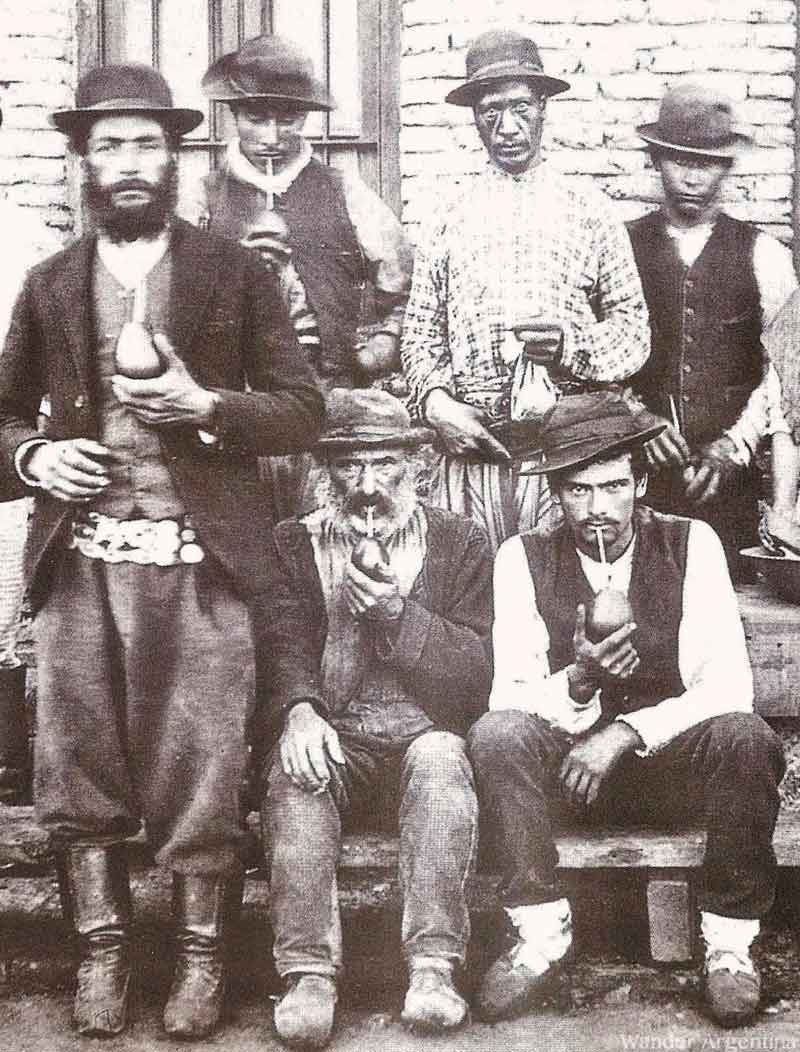
When the Spanish first came exploring the fertile land where indigenous Guaraní people resided, they were on the hunt for precious metals. They didn’t find gold or silver but instead healthy, hospitable people who introduced them to the plant they called Caá. In 1516, Spanish explorer Juan Díaz de Solís was the first to report that the natives here drank a tea-like beverage that ‘produced exhilaration and relieves fatigue.’
A little less than 100 years later, the Spanish decided to establish colonies in this fertile area, named Mesopotamia after the original, which includes the present day Misiones province.
At first, the Jesuit priests who settled among the Guaraní tribes demonized yerba mate calling it a ‘cursed herb’ an ‘abominable vice’ and ‘suggestion of the devil.’ They considered it addictive and thought the practice of spending several hours a day doing nothing but drinking mate was a waste of time. For the missionaries, idleness was the devil’s workshop.
(Even in contemporary times, ‘tomando mate’ is a euphemism for screwing around on the job. If someone works slow, or fails to get their job done on time, it may be blamed on ‘drinking mate’ instead of working.)
Yerba Mate Ban: Too Pagan for the Priests
The ritual of drinking mate was a little too pagan for the priests’ taste too. Initially some missionaries suggested that it was a hallucinogenic. It’s likely that with the language and cultural barrier, the priests were confused because Guaraní also have ceremonial tea they make with a psychedelic compound.
There was another important reason that yerba mate was an impediment to the Jesuit’s evangelism; slave labor conditions imposed on the natives to harvest the yerba in the wild generated understandable hostility.
A year after they established the Jesuit missions of Paraguay in 1609, the Inquisition of Lima outlawed consuming or trafficking yerba mate. The crime was punishable by 100 lashes for the indigenous people or 100 pesos for colonizers, writes yerba mate expert, Jerónimo Lagier, in his book, ‘The Adventure of Yerba Mate.’
The Guaranís were not willing to give up their ‘drink of the Gods,’ so central to their lifestyle and the yerba ban failed miserably.
The First Yerba Mate Plantations
Within a couple of decades the Jesuits, who had long observed the endurance of the Guaranís, and also noticed that yerba mate could stave off malnutrition, changed their tune. Anyway, they preferred the natives, who they converted to Christianity by the thousands, drink mate instead of their other main ‘magical drink’, caña con ruda, a rue-infused sugarcane hooch.
So, in a major about face, the Jesuits created the first yerba mate plantations. They discovered that the seed of the plant has to pass through the digestive track of a toucan to germinate, a secret they closely guarded. The Jesuit yerba mate plantations generated lots of income for the missions and also made harvesting much less arduous for the locals.
When Spain’s King Charles III expelled the Jesuits from the Americas in 1767, the plantations were abandoned and yerba mate was once again harvested from the wild, until the beginning of the 20th century.
By then, the Jesuits had already sealed yerba mate’s fate as an important part of the Argentine lifestyle and diet though. The wandering gauchos adopted the habit early on and helped spread it to the rest of the country. From the wealthiest Buenos Aires families, who had slaves to prepare and serve mate, to the peasants in the poorest parts of the country, all had mate in common. Drinking mate also was cemented as an idiosyncrasy of the gaucho identity, along with horsemanship and asados (barbecues).
The Unifying Nature of Mate
Yerba mate even played a role in the country’s independence from the Spanish empire claims Pau Navajas, author of the book, ‘Caa Porã, The Spirit of Yerba Mate.’
While discussing the country’s trajectory, at the Congress of Tucumán in 1816, strong regional differences among the 33 provincial representatives were almost impossible to overcome. The delegates shared mate over endless discussions, negotiating minute to major matters of national importance. Finally on July 9, after many rounds of mate, the United Provinces of South America declared independence.
The socially unifying aspect of mate carries on in contemporary Argentina, where 92% of the country drinks it.
Yerba mate is considered so essential to the Argentine diet, that the government’s ‘basic food basket’ includes yerba, along with milk, eggs and sugar. Among the country’s deeply divided classes, only finding out someone is a fan of the same soccer team breaks down social barriers like mate.
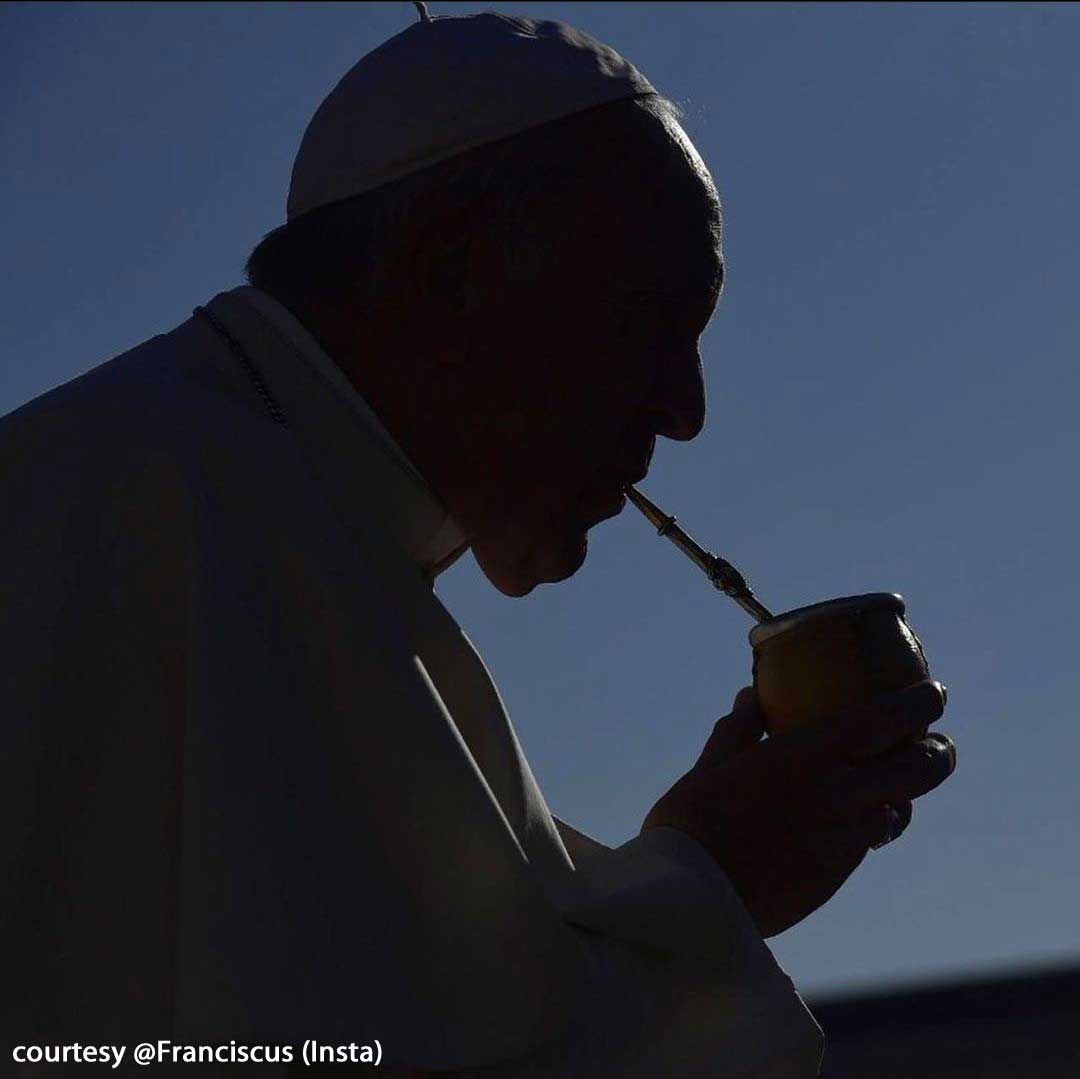
Four hundred years after the church demonized mate, Argentina’s Pope Francis is never far from his mate. While still in Buenos Aires, Bergoglio was known for wandering the streets and sharing a mate with anyone who offered it to him.
Mate’s denomination as ‘the elixir of the Jesuits’ is truer than ever.
Superfood: Health Benefits of Yerba Mate
“Yerba mate raises morale, sustains the muscular system, augments strength and allows one to endure privations. In a word, it is a valiant aid.”— French Society of Hygiene, 1909
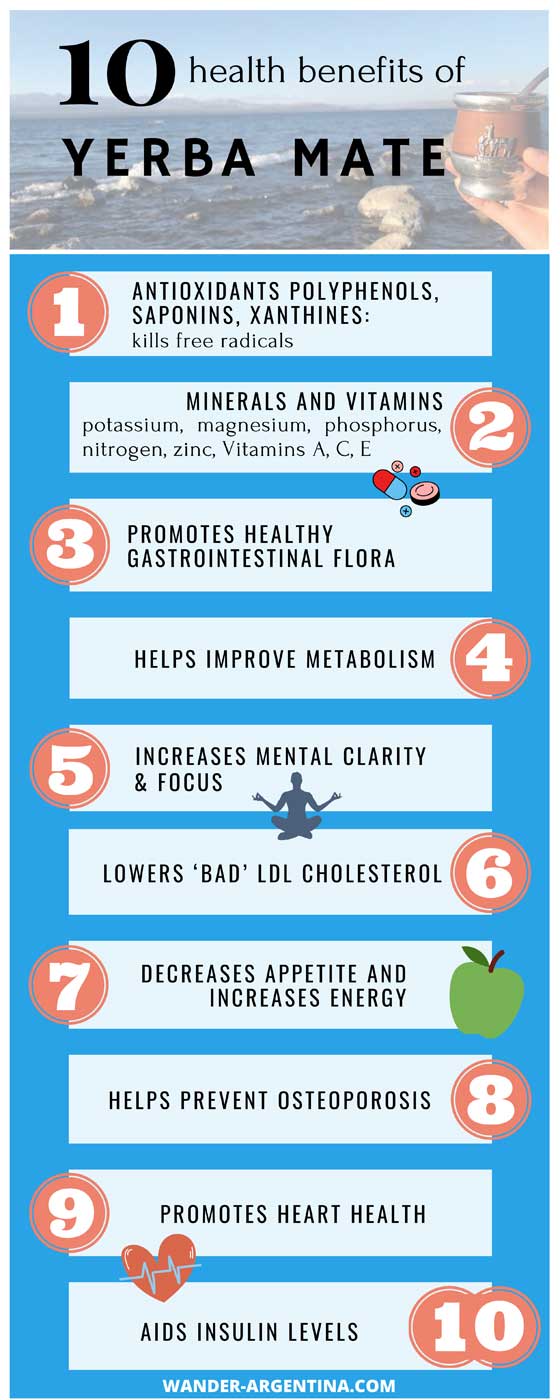
If the grassy taste doesn’t give it away: yerba mate is a uniquely healthy infusion.
Early on, Jesuits missionaries pondered why gauchos were able to survive on a diet of only meat and yerba mate without getting scurvy. The disease, which was common at the time, is caused by vitamin C deficiency.
It is only in modern times that studies confirmed ‘the gauchos’ vegetable’ is a source of vitamins A, C, and E, as well as complex B vitamins, and trace minerals including calcium, iron, magnesium, potassium, selenium, sulfur and zinc. It also contains 15 muscle-building amino acids and phytonutrients including lots of tannins, flavonoids, and chlorophyll.
The green brew is chock full of micronutrient polyphenols, saponins, and xanthines, all antioxidants that that fight free radicals that cause disease and aging.
Those who start drinking mate as adults are able to recognize its appetite suppressant effects. In Argentina and Uruguay it’s common for people to have only a light breakfast of one medialuna or a piece of toast with mate and then not eat a substantial meal until lunchtime.
Gentile suggests even another reason it may help keep of the pounds, “It keeps you from eating, since drinking it is a repetitive motion.”
Studies confrm that the unique nutritional properties of mate help the body fight obesity. A 2015 Brazilian study says yerba mate is an anti-inflammatory and can help people who do everything right but still don’t lose weight, concluding that, “yerba mate modulates the expression of genes that are changed in the obese state and restores them to more normal levels of expression.”
The verdict was backed up by a study from South Korea’s Chonbuk National University. They conducted a twelve-week double blind study using yerba mate supplements, one of the first double blind studies on yerba mate. Even though they used pills for the study, their conclusion was affirming: yerba mate reduced the percentage of body fat and is a ‘potent anti-obesity compound.’
According to the World Health Organization, only six percent of Argentina’s adults eat the recommended five servings a day of fruit and vegetables. The country’s citizens make up the world’s second largest consumer of meat per capita (Uruguay is number one). Nearly two-thirds of Argentina’s adults don’t exercise. Twenty-five percent of the population smokes and the average intake of salt is a whopping double the recommended limit.
Considering Argentina’s trajectory of unhealthy habits, it is notable that cancer rates in Argentina are lower than the United States, Australia and other developed countries. While there are too many variables attribute it to any one thing, it’s also noteworthy that life expectancy in Argentina is only two years behind the United States. Both Uruguay and Argentina have some of the highest life spans in the region.
Even those who do eat a lot of fruits and vegetables typically don’t get the recommended intake of magnesium in their diet, due to soil depletion. Lack of magnesium in the diet can lead to a range of problems from osteoporosis, depression, anxiety, heart problems and fatigue.
Yerba mate’s range of B vitamins help promote brain function and cellular health. Since meatless diets are often lacking in B vitamins, yerba mate can be particularly helpful for vegetarians.
As international interest in yerba mate has grown, new studies continue to surprise researchers. It was only in 2017 that Spain’s Department of Nutrition and Metabolism discovered that yerba mate has 19 saponins (it was previously believed that there were only five).
Saponins are the astringent compound that causes yerba mate to bubble and foam on its surface. Also found in quinoa, another South American superfood, saponins are anti-carcinogenic, increase metabolism, help lower the so-called ‘bad’ LDL cholesterol, prevent buildup of plaque in the arteries and reduce inflammation.
Studies also show that mate helps to preserve bone density in post-menopausal women, and observational studies indicate it helps regulate hormones and prevent breast cancer.
More recent studies are examining the probiotic effect of yerba mate in the laboratory. Probiotics are microorganisms that help promote a healthy digestive tract and prevent some illnesses.
In 2018, scientists from Argentina’s National Scientific and Technical Research Council (CONICET) discovered that yerba mate inhibits the growth of Escherichia coli (E. coli ) and Streptococcus (Strep) in vitro. The breakthrough has scientist eager to study how yerba mate can be used to fight bacterial infections.
Yerba mate can also help diabetics and pre-diabetics regulate their blood sugar according to randomized controlled trial on overweight and obese individuals conducted by a Brazilian public university.
Another study highlights the inverse relationship between the traditional consumption of yerba mate and the development of Parkison’s disease.
Nutritional studies for yerba mate do vary, depending on how and where and how they are produced. It’s not hard to understand why there are some discrepancies between laboratory studies: in studies outside Latin America, many foreign scientists are studying it far outside of its cultural context.
In fact many of the yerba mate studies on the National Institute of Health page call it ‘maté’ with an accent on the ‘e.’ While English speakers sometimes mistakenly write it that way, ‘maté’ means ‘I killed’ in Spanish. This would hint that researchers are not creating experiments that approximate how it is used day-to-day in South America.
Additionally, different varietals of yerba mate have different chemical makeups and nutritional values, so it is almost impossible to standardize testing.
Of course the indigenous Guarani and naturopaths have touted the benefits of yerba mate long before studies confirmed its range of benefits. In her book, ‘The Healing Power of Rainforest Herbs,’ herbalist Dr. Lesie Taylor recommends yerba mate for depression, pain, fatigue, and as an anti-allergen.
Yerba Mate Around the World
“Mate is the partner that gives us great service, even if more than one foreign doctor says it’s a vice. If he tries it, he’s the first to be enchanted, and when he has become accustomed to the benefits it contains, the gringo remains in our land, forever endeared.”
— Tango song, ‘El Mate’ by Evaristo Barrios, 1926
The custom to sip mate is most associated with Argentina in the world’s collective consciousness, but the practice is also ingrained in the neighboring countries where it grows.
Once a taste for mate is acquired, it sticks. But most of the world has not discovered the benefits of yerba mate — it is still only exported to 16 countries.
Even Argentines will concede that Uruguayans are the true ‘masters of mate’. The average Uruguayan goes through almost nine kilos of yerba per person per year, compared to 6.4 per person in Argentina.
The materos on the other side of the River Plate are famous for drinking mate on the move, carrying a mate in-hand and thermos under the arm, for trips to the park and the beach. It’s not uncommon to see Uruguayans drinking mate while riding a bike, or driving.
The custom of taking mate ‘out into the streets’ began in Uruguay when waves of immigrants who lived in the cramped quarters of Montevideo started socializing outdoors.
Later, under the Uruguayan Dictatorship of 1973-85, carrying a mate became a low-key revolutionary symbol for worker’s rights. In 1999, city leaders in Montevideo raised ire when they banned mate drinking during public performances because the slurping distracted performers.
One thing that surprises even many Argentines is that Syria is still the world’s largest importer of yerba mate outside South America. Nearly three-fourths of Argentina’s exported mate goes to Syria.
Syria and Lebanon were the first countries outside of South America to import yerba mate, after it became popular among those who immigrated to Argentina beginning in the 1860s. The ‘Turkos’ (they were referred to as ‘Turks,’ because immigration started before the fall of the Ottoman Empire) traveled back and forth from Argentina for the next century, depending on the economic and political tides, but the mate habit stuck.
The Syrian style of drinking mate uses a smaller drinking vessel and straw. The tea is presented on a tray with lemon slices and sugar. While in Argentina cleaning the lip of the bombilla between turns is considered ill-mannered, the Syrian Druze who drink mate use the lemon slices to sanitize the straw between serving.
Yerba mate is also exported and consumed in various European countries who had early immigrant populations in Argentina, most notably modern-day Ukraine and Poland.
Sport fans may have noticed that mate has become popular among non native drinkers in the European Soccer leagues, such as Cristiano Ronaldo and Eric Dier after Lionel Messi, Luis Suárez, Neymar Jr. and other South Americans introduced it to their teammates.
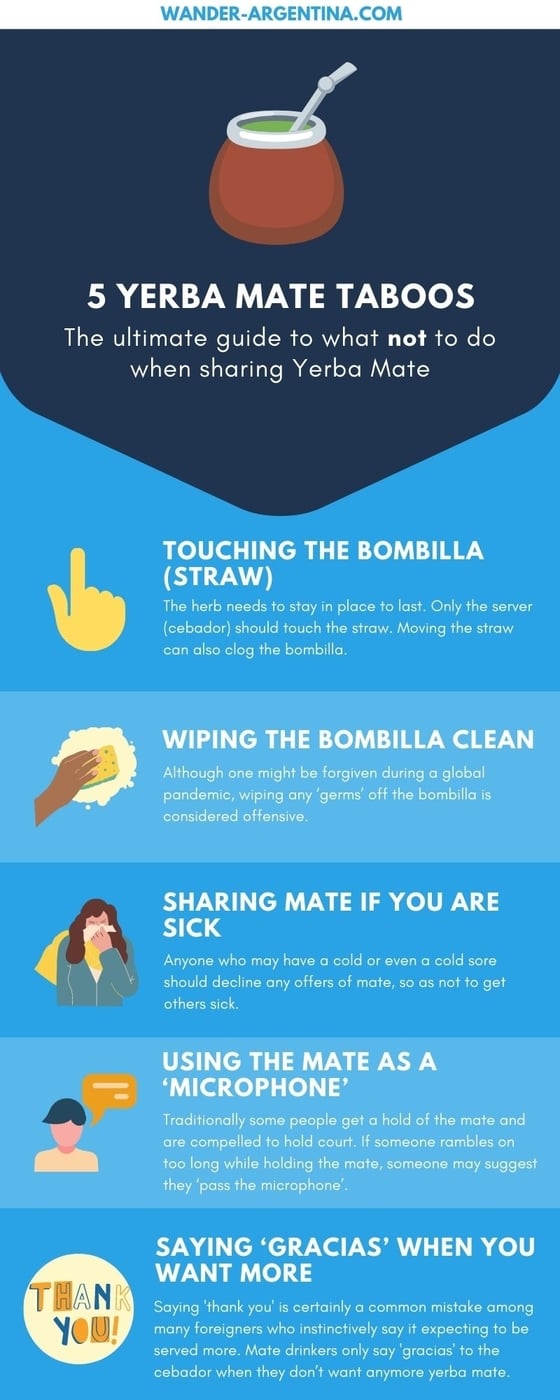
Is Yerba Mate Safe?
While yerba mate is finally gaining its rightful status as a superfood, there can be too much of a good thing. Anyone who has been told by his or her doctor to avoid caffeine, should skip the mate.
Foreign doctors would advise pregnant women not to consume yerba mate because it has caffeine; in Argentina they just tell them not to overdo it. While it is common for children to drink yerba mate before they know how to tie their shoes in regions where mate grows, the United States Food and Drug administration warns against giving mate to children.
The World Health Organization only removed yerba mate from its list of ‘possibly carcinogenic’ foods as recently as 2016. It was Argentina’s National Institute of Yerba Mate (INYM) who challenged the familiar ‘demonization’ of yerba mate, classifying it as possibly cancer-causing.
Researchers successfully demonstrated that yerba mate’s correlation with cancer in the upper digestive tract had not to do with yerba mate itself, but high water temperatures used to prepare it. The original mate experts, the Guaraní, traditionally drank it with warm water. It wasn’t until Europeans arrived that people started preparing mate with hot water.
Mate sommelier, Karla Johan, says mate should be consumed at temperatures no hotter than 75-82(°C) degrees (167-180 °F) to mitigate the risk of oral cancers. “In reality, no tea should be drunk above that temperature for health reasons,” she adds.
In a study by Argentina’s National University of Misiones, consumption of yerba mate, (as well as black tea, and to a lesser extend, coffee) were shown to inhibit the absorption of iron. Since Argentinians and Uruguayans are the two countries with the highest per capita consumption of red meat, the effects of lowered iron levels are negligible for most of the population.
According to some scientists, the ‘heart healthy’ aspect of mate helps diminish the adverse effects of too much red meat in the diet. Drinking yerba mate only between meals, as is custom, also lessens any harm of iron loss.
It’s also worth noting that traditional yerba mate brands can contain polycyclic aromatic hydrocarbons (PAHs), a known carcinogen found in smoked foods and tobacco. The traditional method of curing yerba mate leaves after harvest involves drying them over fire. PAH’s are a health hazard with all smoked foods. The traditional smoke-dry process of yerba mate is also inefficient and bad for the environment, but many enjoy the smokey flavor.
Researchers from CONICET are working with producers to develop more efficient methods to try the mate.
To avoid PAH’s the health conscious will want to purchase non-smoked yerba mate varieties. When buying yerba, look for a label that says, ‘elaborado sin humo’ — this means the leaves were dried without smoking them.
Yerba Mate Versus Coffee Versus Green Tea

While there is a thriving café culture in Buenos Aires, Argentines consume five times more yerba mate per year than coffee. With mate consumption at 100 liters a year per person, it’s clear what they prefer. But how do yerba mate and coffee and green tea compare?
It is commonly touted that yerba mate has less caffeine than coffee. While this is true for ‘mate cocido’ or mate made with tea bags, it does not apply to ‘mate con bombilla’, made the traditional way.
There is no uniform way to quantify how much caffeine traditional mate has because it depends on the size of the gourd used, the yerba used, the temperature of the water and the number of mate rounds one drinks.
In a 2009 study by Argentina’s National Institute of Yerba Mate (INYM) it was determined that a mate made with 50 grams of yerba, drunken with one half liter of water (three or four average mates) packed quite a punch, with 180 milligrams of caffeine.
A standard cup of coffee has 120mg of caffeine.
Mate steeped with 50 grams of yerba per liter contains 70-80 mg of caffeine. Green tea has 25mg of caffeine, about the same as a weak mate cocido.
But while green tea enjoys a reputation as a healthy alternative to coffee, loose-leaf yerba mate contains 20% more antioxidants, which fight free radicals and help impede aging.
Yerba mate is also not acidic. Coffee has a PH level of 4.7, depending on the type of blend. Yerba Mate, has a PH range of 6.0 up to 7.0 — it is neither alkaline nor acidic.
At one point in a bit of sly Argentine marketing, claims were made that yerba mate did not contain caffeine at all, but a chemical cousin called matiene. The assertion that mate contains an entirely different chemical has been debunked, but it’s indisputable that yerba mate gives a different type of caffeine buzz to coffee.
The difference can be explained by diverging ratios of the other psycho-stimulant methylxanthines in yerba mate: theobromine and theophylline (which is also a bronchodilator, used in the treatment of respiratory diseases).
These two alkaloids counteract some of the negative effects of yerba mate’s caffeine, making drinkers feel alert, but relaxed instead of wired.
Mate’s unique chemical makeup also inhibits lactic acid buildup in the muscles, preventing the muscle tenseness and twitching that too much coffee can cause.
How to Start Drinking Mate?
(*This is post may contain affiliate links; if you make a purchase we may receive a small commission at no extra cost to you.)
“Mate is a powerful bond without sinews, it is a tender lover without kisses or caresses, a warmth without flames, a friendly offering…”-
-writer, Federico Oberti, 1971
Picking up a mate habit requires a bit of an initial investment, for the mate and bombilla, but it pays off quickly. Those visiting Argentina can easily find mates for sale in any big street bazaar, such as Buenos Aires’ San Telmo Fair and Mataderos Market.
For about thirty bucks people can buy a mate starter kit online that includes a gourd, bombilla and the mate herb. Traditional gourds will need to be cured before use, but the kits come with instructions.
Any kettle will work to prepare mate, but you need to keep an eye on the water to make sure it doesn’t get too close to boiling. True connoisseurs will want a durable electric kettle that has a nifty temperature control like this stainless steel one or this less expensive one.
Those who want to make like an Uruguayan and drink mate on the move, will need a thermos. A stainless steel thermos with a spout, so that the cebador can carefully pour the water into the mate without ruining it is perfect.
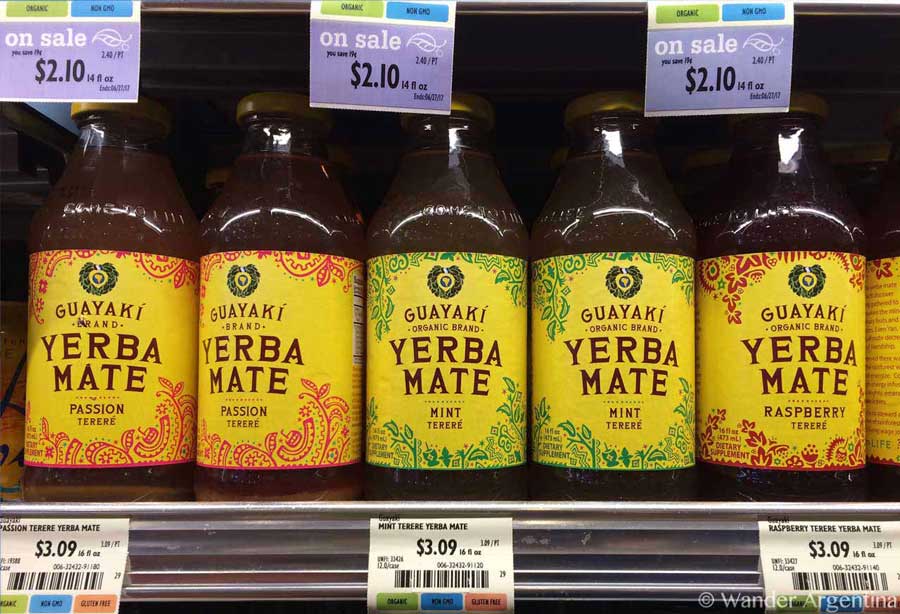
Where to Find Yerba Mate & Which to Buy?
In Argentina, the herb itself can be bought in any grocery store — there is a whole aisle just for yerba mate. Those in big cities outside South America may be able to find yerba mate at their local Latino market, or order it online.
Different brands of mate have different levels of caffeine and other compounds, so getting into the world of mate is a culinary adventure all its own.
Further confusing things is that yerba harvested at certain times of year has different chemical makeups and caffeine levels. Larger producers tend to combine yerba from different harvests to provide some consistency to the product.
Those who want to start off with a full-bodied but less bitter type of yerba can try ‘yerba mate con palo,’ which means it has little sticks. This is also preferred for those planning to prepare mate with a French press, as varieties sin palo (without sticks) are too dusty, will clog the strainer and leave particles floating in the tea.
Larger commercial brands’ less bitter varieties may also be labeled ‘yerba mate suave.’
Those who do enjoy a bitter kick will want ‘gaucho style’ yerba, such as Brazil’s most famous yerba brand.
Paraguayan-produced yerba mate also tends to have a rustic, robust taste, and is perfect to make the cold mate beverage, tereré.
Today, descendants of the original Guaraní tribes continue to be the primary harvesters of mate, often in poor labor conditions. Traditionally, the harvest of yerba mate is a family affair, with children working alongside their parents, a practice that continues today.
It’s not the cheapest but fair-trade, organic and ‘unsmoked’ yerba mate is the best choice for the conscientious because it doesn’t have pesticides or PAHs, and is produced with fair labor practices.
It turns out that drinking organic, sustainably-produced mate may become good for the environment too. Because the Jesuit style of producing yerba mate on clear-cut fields causes soil erosion, farmers have an incentive to reforest the land where they cultivate it.
Good quality yerba mate also requires shade provided by larger trees. Foreign demand for organic, renewably-produced mate can help spur agroforestry efforts in the already mostly depleted Atlantic forest.
-Ande Wanderer
Mate Yerba Products Online
→ A modern yerba mate set is ideal such as this travel-friendly one because using the traditional mate gourd can be a little tricky for novices.
→ Those who just want to try mate, and are not sure if they want to start a mate habit can just order a bombilla online and use a regular cup for mate at first to try it out.
→ Alternatively there are relatively inexpensive sets that include just the mate and bombilla
→ Bags of traditional yerba mate from Argentina’s top brands can be ordered online but the healthiest yerba mate option for people and the planet is unsmoked, organic yerba mate.
→ Those with finely tuned tastebuds may want to try gourmet varietals such as this brand, which is also organic and unsmoked, but still provides a strong flavor without a strong grassy aftertaste common to some unsmoked brands. It also comes in a nifty burlap sack.
→ Far from traditional mate, but yerba mate carbonated drinks are at least a tad healthier than regular soda. A company in Miami has manufactured a hipster yerba mate soda since the 1960s called Mavera that was originally produced in Cuba before the revolution.
→The most popular carbonated yerba mate soda on the market is Guayaki’s Yerba mate classic sparkling soda also have interesting flavors such as grapefruit ginger mate soda.
→ Newer carbonated mate products include flavors such as this Brooklyn Mate soda with Ginger, Lemon and Vanilla and from one of the leading organic Yerba Mate producers who
→ As entrepreneurs hop on the yerba mate bandwagon, there are now appearing guilt-free no calorie yerba mate drinks, that nevertheless offer quite a kick such as this sparkling yerba mate drinks with flavors such as mango passion-fruit that provides a caffeine boost of 160 mg per drink.
Yerba Mate as a Replacement for Booze?
→ Perhaps picking up a yerba mate habit can be a healthy replacement for booze, some surmise. Not only does it give people a lift, it keeps the server’s hands busy, and the ritualistic nature of drinking mate still provides a hallowed social experience.
Companies seem to be exercising this idea as a marketing angle and new sugar-free organic yerba mate soda options such as the ‘Clean’ brand, are marketed toward those in recovery. It’s also a tad ironic because many tout yerba mate as an excellent hangover cure.
Specialty Native Teas Similar to Yerba Mate
→ The North American cousin of Yerba mate is called Yaupon, which is so obscure it is sold by only one company online. It was traditionally consumed by Native Americans. It’s the only caffeinated drink native to North America. Early botanists apparently confused it with another native drink that caused purging when they named it ‘Ilex vomitoria’. It is harvested from the wild in the Southeastern United States.
→ Ecuador has a similar tea to mate called Guayasa. It’s also from the Holly family, is full of antioxidants and gives a good caffeine boost but without the bitterness typical of yerba mate.

